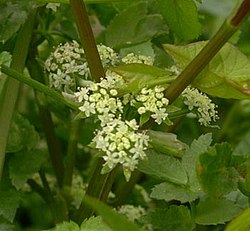Helosciadium nodiflorum
| Fool's-watercress | |
|---|---|

| |
| Scientific classification | |
| Kingdom: | Plantae |
| Clade: | Tracheophytes |
| Clade: | Angiosperms |
| Clade: | Eudicots |
| Clade: | Asterids |
| Order: | Apiales |
| Family: | Apiaceae |
| Genus: | Helosciadium |
| Species: | H. nodiflorum
|
| Binomial name | |
| Helosciadium nodiflorum | |
Helosciadium nodiflorum[2] (synonym: Apium nodiflorum), fool's watercress,[1] is a flowering plant found in ditches or streams, as well as fresh and brackish-water wetlands native to western Europe. It is not poisonous to humans but it could be easily confused with the allegedly poisonous lesser water parsnip.
Description
Helosciadium nodiflorum is a low-growing or prostrate hairless perennial up to 1 m tall, with a thick, hollow, faintly ridged stem which, when lying down (procumbent) produces roots at the nodes. It has glossy

Taxonomy
In 2010 a taxonomic revision demonstrated that the genus Apium was polyphyletic and needed to be split into three genera. Five of the 7 European species of Apium were therefore moved to the genus Helosciadium, as had first been proposed by Wilhelm Koch in 1824. Apium nodiflorum was among them, and is therefore now correctly called Helosciadium nodiflorum W.D.J. Koch.[4]
The genus is noted for the high rate of hybridization between its species, and the following hybrids have been described:
- × Beruladium procurrens A.C. Leslie (Berula erecta × H. nodiflorum)[5]
- Helosciadium × moorei (Syme) Warren (Helosciadium inundatum (L.) W.D.J. Koch × H. nodiflorum)[6]
- Helosciadium × longipedunculatum (F.W. Schultz) Desjardins (Helosciadium repens (Jacq.) W.D.J. Koch × H. nodiflorum)[7]
- Helosciadium × clandestinum Rita, Capó & Cursach (Helosciadium bermejoi (L. Llorens) Popper & M.F. Watson × H. nodiflorum)[8]
Distribution and habitat
Helosciadium nodiflorum is common throughout England, Wales and Ireland but much less so in Scotland.
Uses
Wild fool's watercress has been traditionally harvested and consumed in several Mediterranean countries, including Spain, Italy, Portugal and Morocco[13] The edible young leaves and tender shoots can be used raw in salads, boiled, or used as a condiment in soups and other dishes.[14][15]
References
- ^ . Retrieved 16 November 2022.
- ^ "Helosciadium nodiflorum (L.) W.D.J.Koch | Plants of the World Online | Kew Science".
- ISBN 978-0-7232-5175-0.
- S2CID 21921727.
- ISSN 1996-8175.
- S2CID 90980061.
- ISSN 2632-4970.
- ISSN 1617-1381.
- ^ Apium nodiflorum Peter Llewellyn Wild Flowers of the British Isles, Accessed 2011
- ^ Fool's-water-cress Wild flowers of Ireland. Accessed July 2011 Apium nodiflorum Fool's-water-cress]
- ^ Apium nodiflorum (Fool's-water-cress)
- ^ envirolink.govt.nz https://envirolink.govt.nz/assets/Envirolink/1624-HZLC127-Manawatu-Wanganui-Estuaries-Habitat-Mapping-Vulnerability-Assessment-and-Monitoring-Recommendations-Related-to-Issues-of-Eutrophication-and-Sedimentation.pdf. Retrieved 7 September 2021.
{{cite web}}: Missing or empty|title=(help)[title missing] - ISBN 978-1-4939-3327-3.
- ^ Parada, M; Carrió, E; Vallès, J (2011). "Ethnobotany of food plants in the Alt Empordà region (Catalonia, Iberian Peninsula)". Journal of Applied Botany and Food Quality (84): 11–25.
- PMID 26944238.

